
Days are long and time is passive. While having another round of ‘Chai’ (tea) in the morning, I was asked to go and fetch the 15 kilograms of subsidized rice sanctioned by the state government of Kerala, dispersed through public distribution system. Apart from a grocery and medical shop, everything else remained closed on the street. The hustle and bustles were gone, so were the noisy vehicles on the roads. Few people were already standing in a queue in front of the ‘ration shop’ adhering to the norms of social distancing, these shops come under the essential services and were asked to remain open throughout the week. While filling the bag with rice, the shopkeeper told us that there would be a distribution of five kg rice and pulses as announced by the central government in the coming week.
People are reluctantly getting used to their newfound way of life. India fights Covid-19. The battle has begun and the future seems unpredictable...
1
The first case of COVID-19 in India was reported on the 30th of January 2020. A student of Wuhan University who had travelled to India, was tested positive in Kerala, a south-western coastal state. In a couple of days three more students who came back from Wuhan tested positive for the coronavirus. The cases started escalating in the month of March, most of these cases were reportedly linked to the foreign returnees. On 12th March, India’s first COVID-19 death was reported in Karnataka, another southern state. The victim was a 76-year old man who had returned from Saudi Arabia.
Fear was looming in the air for long, while China went ahead with stringent measures of locking down several provinces, India decided to bring its citizens back home. On February 1st India evacuated 324 people from the Wuhan region which included both students and working professionals. On February 2nd a second Air India flight landed in Delhi carrying 323 Indians and seven Maldivians from China, on a third evacuation mission on 27th February, the Indian Air Force brought 76 Indian and 36 foreign nationals back to the country. During this mission India provided China with 15 tonnes of medical assistance including masks, gloves and other emergency medical equipment[1]. More evacuations were conducted from the various virus-stricken countries including Italy and Iran in the consequent days.
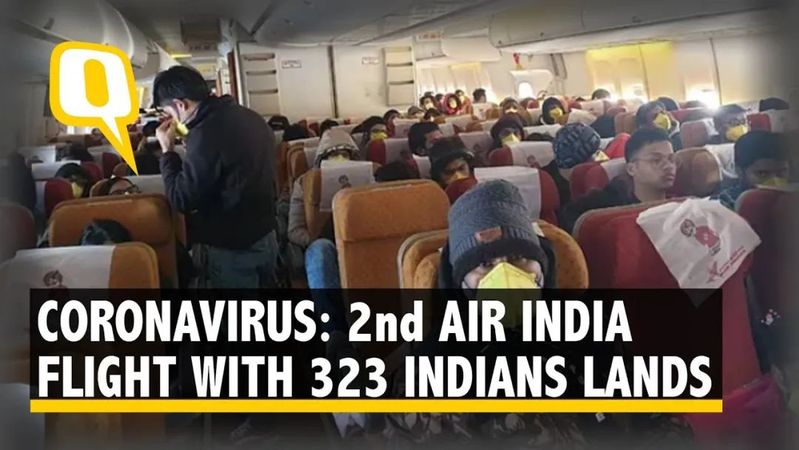
2
With the global spread of novel coronavirus and increasing cases in India, the Central government, subsequently took a number of proactive measures such as travel restrictions, screening of passengers, suspension of visas and self-quarantine measures to effectively contain, prevent and manage the spread of this coronavirus. On 19th March the government announced suspension of all incoming International flights which was later extended till 14th April 2020.
As more cases started appearing, many states (provinces) started taking this problem with serious consideration and adopted methods to tackle it within their own capacity. These measures were taking place in different parts of the country in a scattered manner. On March 22nd, 2020, India observed a “Janata (people’s) curfew” declared by Prime Minister Narendra Modi, the Prime Minister urged people to stay indoors from 7 am to 9 pm which was considered as a ‘litmus test’ of the nation’s ability to conduct a comprehensive lockdown[2]. “This is the start of a long fight” Modi tweeted as the curfew came to an end and people came out of their home to clap, bang metal vessels and ring bells to cheer up the spirit of medical workers fighting against the spread of coronavirus[3]. This incident helped to gather a nationwide momentum to the various efforts happening in different parts of the country, people started to realise that what was considered as a foreign problem so far, has now reached their own door steps. Further on 24th March, the prime minister ordered a nationwide lockdown for 21 days, starting on 25th March to 13th April, affecting the 1.3 billion population of India. It was the biggest and most severe action undertaken anywhere to stop the spread of coronavirus[4].
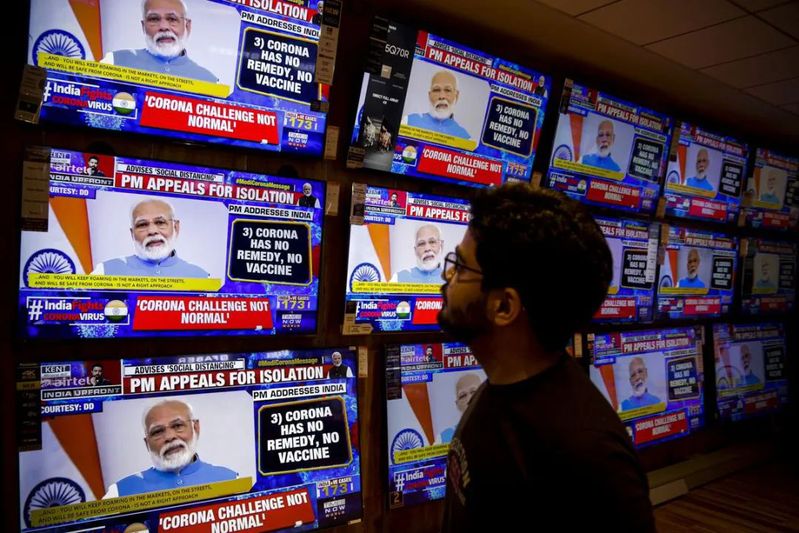
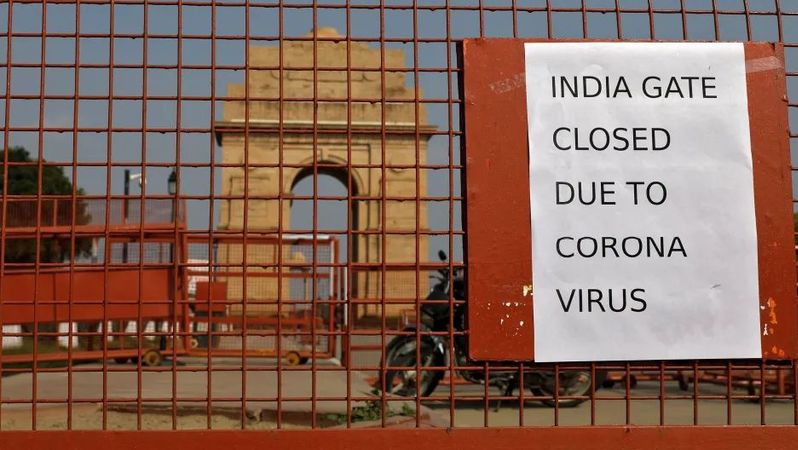
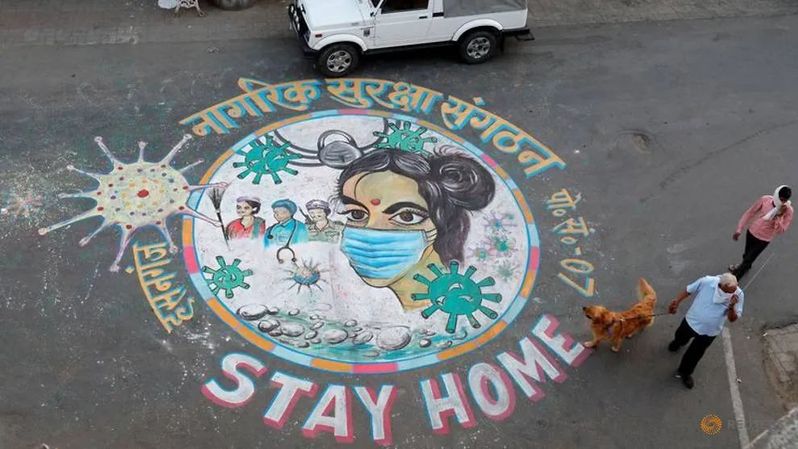
“There will be a total ban of coming out your homes” the Prime Minister announced on television. “If you can’t handle these 21 days, this country and your family will go back 21 years”, Mr. Modi said[5]. Though India’s number of reported coronavirus cases was below 500 at the time of announcement, it was anticipated that if the pandemic hit India in a severe way, the consequences would be bigger than anywhere else in the world. With limited resources and vast population, prevention was the best option India had, to tackle the crisis.
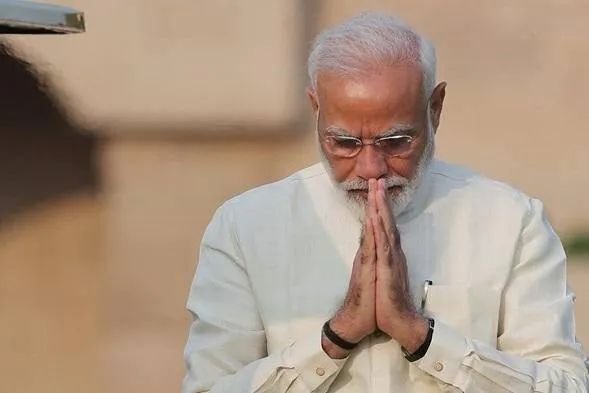
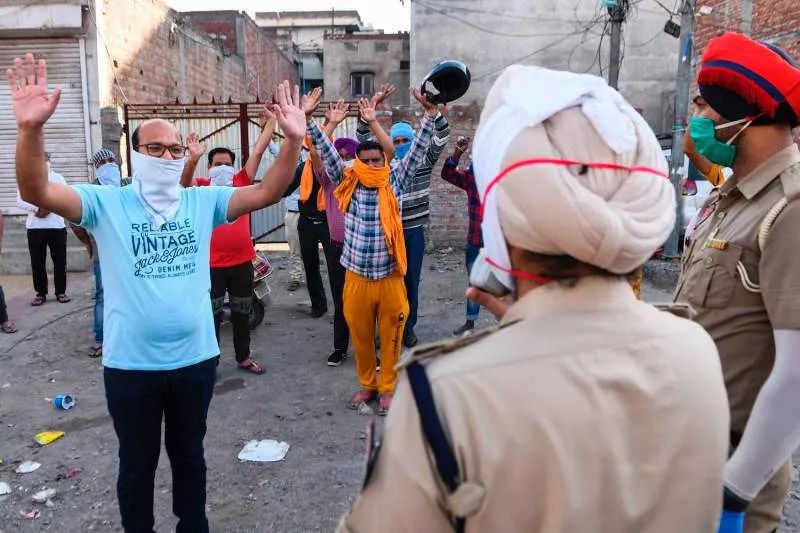
Considering many other foreign nations, India took steps to resist COVID-19 in a much earlier stage. The quick and early attempt to lock down the nation in order to prevent the spread of virus was received with much appreciation from the WHO and other experts[6].
3
The announcement however came on a short notice and did not grant much time to prepare for the days to come. Everyday life, business, offices, temples, schools, transportation and airspace came to a standstill in just a matter of few hours. The following days saw a haste of migrant workers rushing from big cities to their rural households. A lack of clear risk communication from the top leadership and ambiguous directions across the system created much chaos[7]. Administrative machineries struggled to cope with the sudden and unprecedented challenges which resulted in creating tension and confusion in many parts of the country.
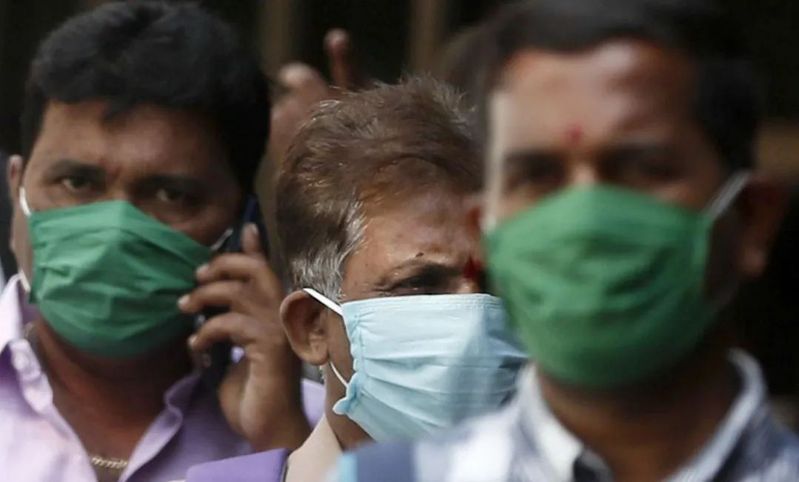
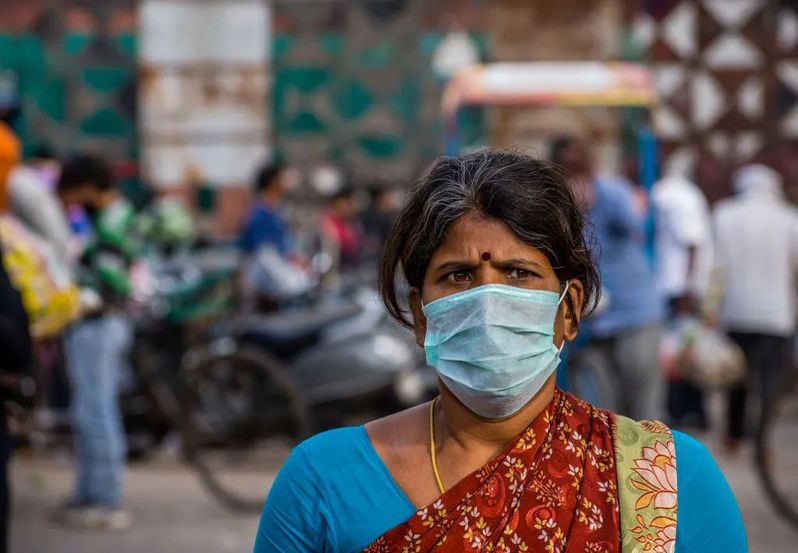
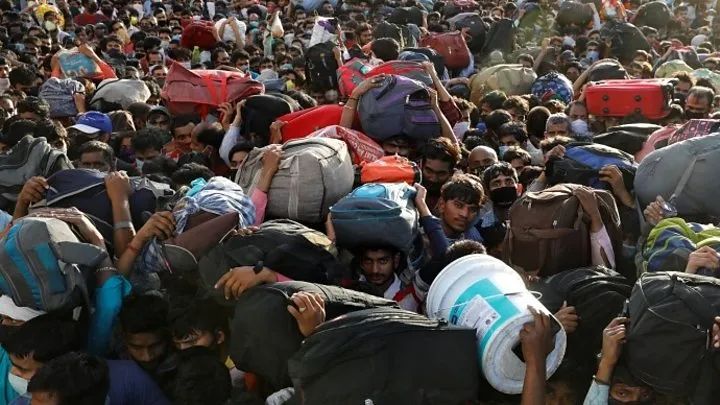
India has some of the most densely populated cities in the world and the social structure of joint families is also prone to the spread of virus. For a country of India’s magnitude and complexities, prevention seems the best cure, though India also has some built in advantages such as the median age of the population being around 28, compared Italy’s 45 [8].
Social distancing became the mantra of the lockdown as people were asked to stay inside their houses. This came with a price. For the majority of Indians social distancing is a luxury they can’t afford, life became difficult for many in the absence of daily wages which was disrupted when the world’s seventh largest economy came to a halt. India’s unorganised, informal industry which employs about 424 million labourers, some 90% of the total workforce[9], a population greater than the combined size of U.S., the U.K., and Australia. For instance, Mumbai’s famous dabbawalas (lunch box carriers), have worked all day for the past 130 years, delivering home-cooked lunches to people’s workplaces and schools, they have braved heavy floods and terrorist attacks, but their service was halted due to coronavirus forcing some 5000 delivery men to stay at home[10].
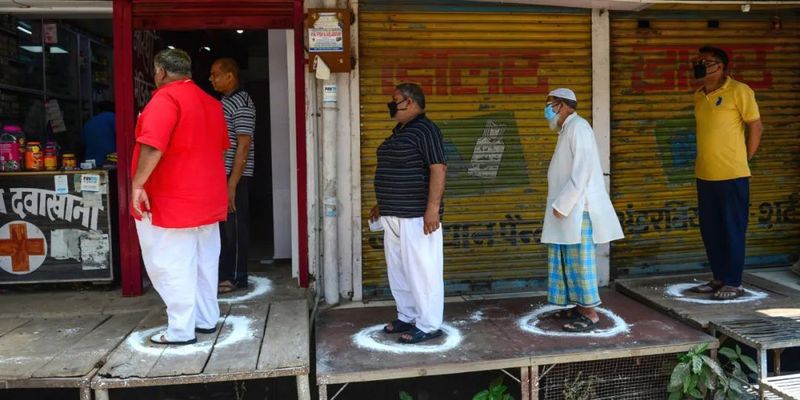
Businesses have closed, unemployment has risen and productivity fallen. With 75% economy under lockdown, analysts see sharp fall in India’s GDP[11]. Barclays predicted that the total shutdown would cost India around $120bn, or 4% of the country’s GDP[12]. This will further depend on how well India can tackle the pandemic as well as the performance of the global markets.

4
On 26th March 2020, finance minister Nirmala Sitharaman announced a $22bn package relief for the ailing nation. As a part of this package about 800 million people would get free cereals and cooking gas apart from cash through direct transfers for three months. A medical insurance for health workers up to $66,500 was also announced as part of the package[13].
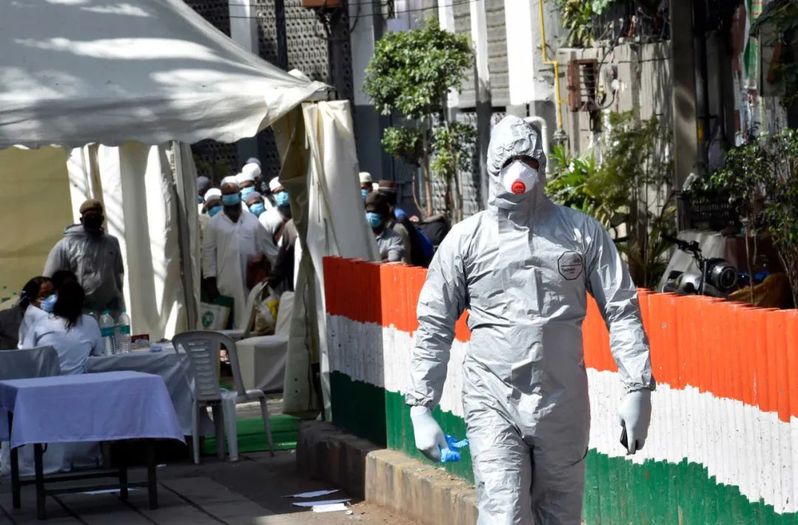
Apart from the assistance from Central government, each states and union territories has also come up with their own relief packages and interventions to mitigate the distress of people[14]. India is a Union of states, federal in structure, unitary in spirit. This union comprises of 28 states and eight union territories (governed directly by the Centre), for a total of 36 entities. The states are created initially on the basis of languages and are different from each other in many aspects. The powers of the state and centre are clearly defined under the constitution. With central government at the helm, state governments function within their demarcated limits. When it comes to an epidemic of this magnitude, the size and diversity of India creates hindrances in the effective implementation of available resources and expertise. Having a federal form of governance system, Centre and States has their own distinct roles and responsibilities. Public health and Law and order come under the purview of the states, and this gives them more power to systematically devise and implement programs.
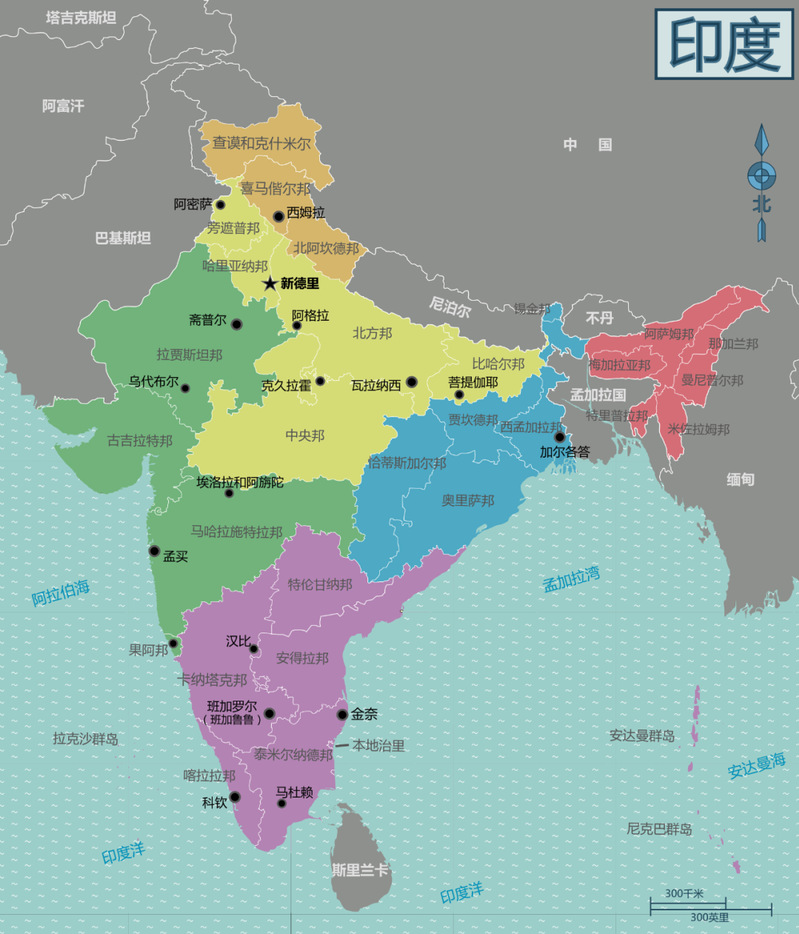
A country which is so diverse in language, ethnicity, culture and geography, states spearhead the decentralised initiatives which involves not just medical expertise but community mobilisation also. Efficiency of this local governments depend on a number of factors such as health policy, infrastructure, fund allocation, availability of work force, coordination with different departments and proper leadership and guidance. For instance, the state of Kerala ruled by a communist government has taken immediate and effective measures to curb the outbreak. It received much appreciation from home and abroad as a model worth to emulate [15].
5
Apart from the governmental administrative machineries, non-governmental actors also have a major role in times like this. With their community level influence and grassroot functioning, these non-governmental and civil society organisations play a major role in the society. Central government has requested them to help local administrations to mitigate the distress of vulnerable and needy groups by identifying hotspots, deputing volunteers and delivering services to the struggling people. It is reported that in 13 states, NGOs fed more people than government did during the lockdown period[16].
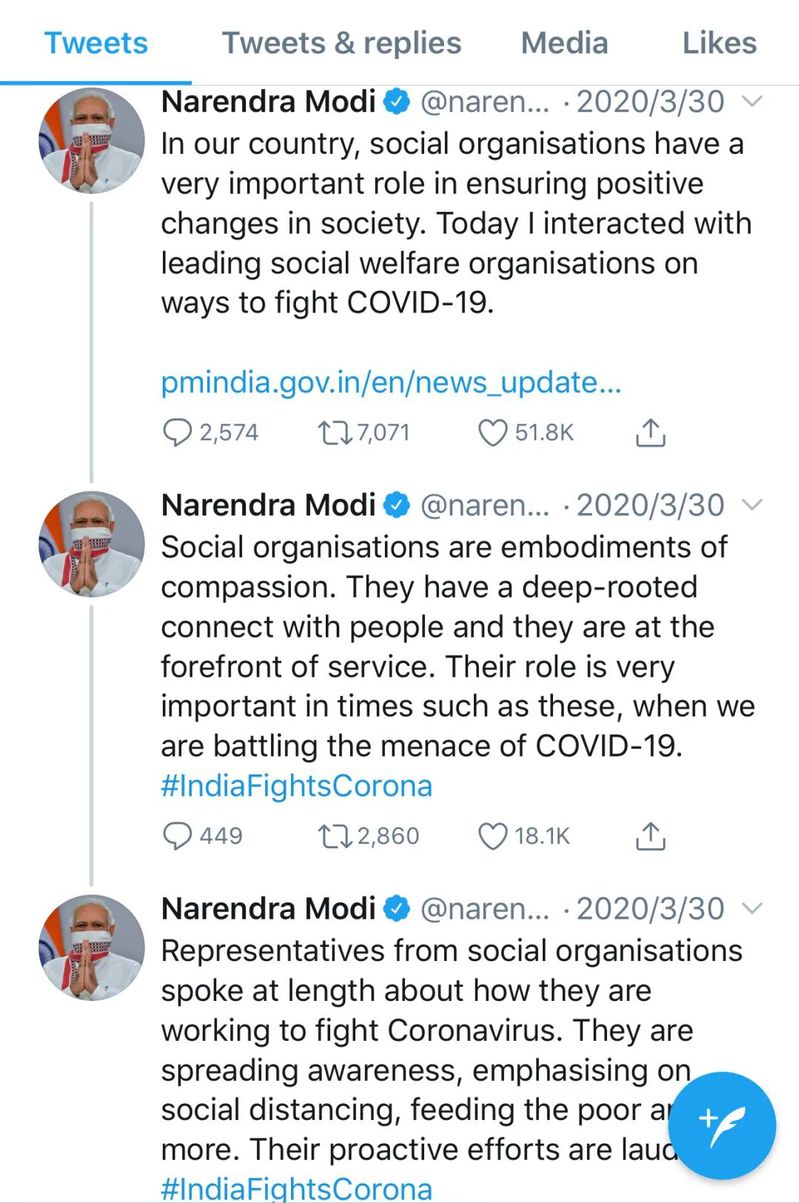
In order to safeguard the global public health, International communities also lent a hand to support India’s efforts. China has rose according to the occasion and agreed upon sharing experience, providing assistance and open its channels for procurement to its neighbour[17]. As a token of support, China donated 170,000 personal protection equipment kits to India to fight the COVID-19 menace[18].
6
Multifaceted, this pandemic asserts a wide-ranging impact on all aspects of life.
Decreased mobility made people turn more to the internet. With a 40% overall internet penetration and 566 million monthly active users, India is second to China in terms of internet users[19]. Of the total user base, nearly 293 million active internet users reside in urban India, while 200 million users in rural India[20].
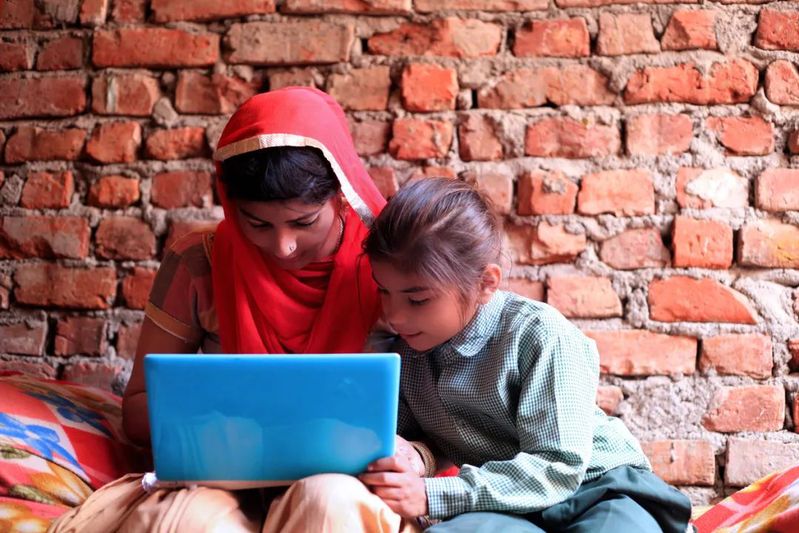
Indian mobile users have been enjoying the cheapest mobile data tariff in the world for years. While it costs $0.26 per 1 GB 4G data in India, the global average is $8.53 per GB[21]. After the nation underwent the lockdown mobile data consumption increased by 30%[22]. Data consumption in certain networks jumped nearly 100% in rural areas during the lock down[23].
Confined to their homes, people tend to spend more time online and this has resulted in technical glitches caused due to heavy data traffic. On March 25, all video streaming services, jointly decided to offer only SD quality content on cellular networks, they also decided to lower the bitrates to 480p to lower the stress on telecom networks throughout the 21-day lockdown[24]. The Indian Broadcasting Foundation, which promotes television Industry came up with offering fee waiver for four pay channels for two months. As the screen time high rockets, so does the demand for novel ways of entertainment. TikTok, the video sharing platform from China’s ByteDance, currently having a userbase over 200 million, became the most downloaded app among social media applications surpassing WhatsApp and Facebook[25].
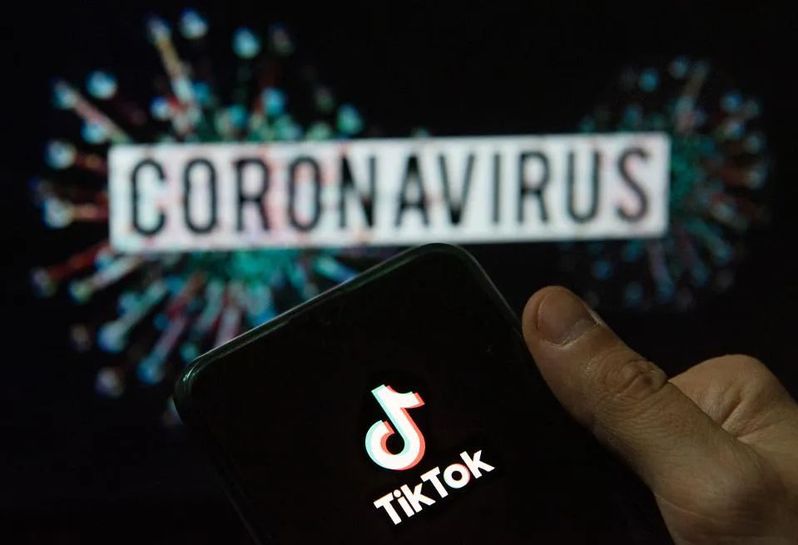
7
India has a thriving media scene with a growing multilingual media industry. Around 197 million households possess a TV set. Of the nearly 900 private TV stations around half of them devoted to news coverage. Doordarshan, the Public TV, reaches hundreds of millions of viewers in different channels. AIR (ALL India Radio) a state-owned radio channel reaches 99% of the population. There are around 17,000 newspaper titles with a cumulative circulation of more than 400 million[26].
A quick escalation in the media consumption came up with opportunities, challenges as well as responsibilities. Apart from providing accurate information on the spread of virus and government instructions, media also took initiatives to help people make their quarantined stay healthy, productive and educated.
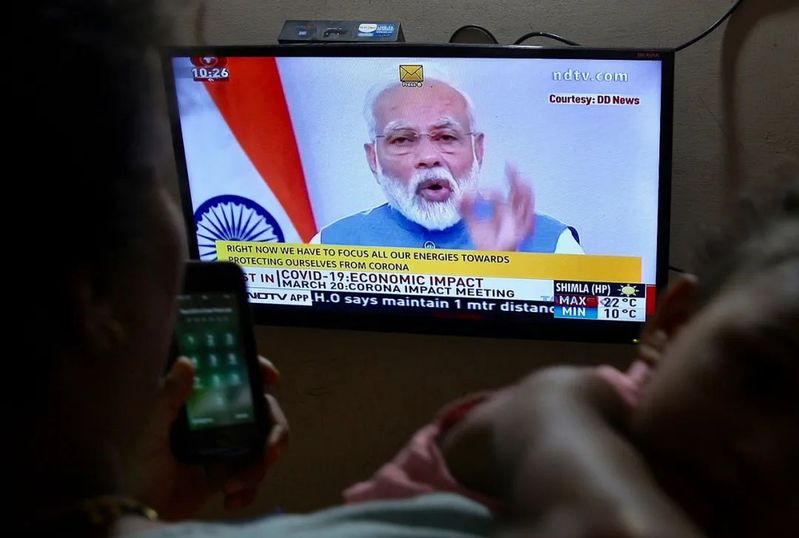
The COVID-19 outbreak unlocked the ‘infodemic’ of misinformation. Information from the myriad sources started to spread even faster than the virus. Though the traditional media had some mechanisms to verify the credibility and sources, Cyberspace emerged as the fertile soil for spreading false and misleading information. Under the disguise of legitimate information, xenophobia and racism often appeared in internet with far reaching implications in the social life. Contrary to the evidences, a viral rumour spread online that people who eat meat were affected by coronavirus, causing “#NoMeat_NoCoronaVirus” to trend on twitter[27]. Magical remedies and ancient wisdoms appeared on the web of information lacking credibility and evading inspection[28].
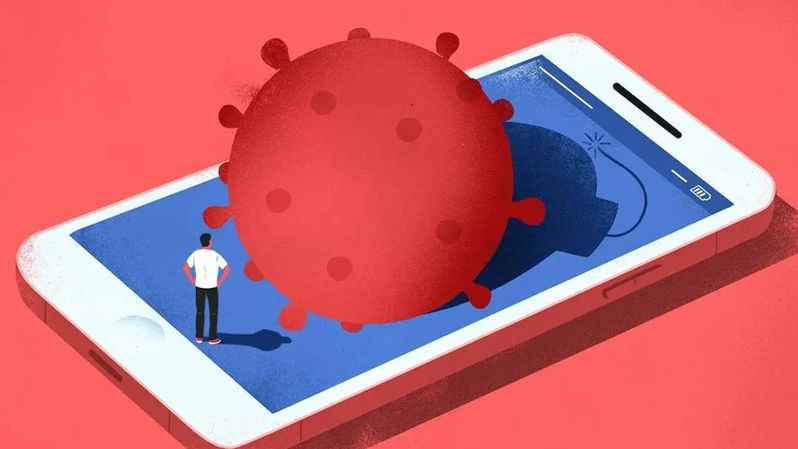
Cases of harassment of people from Northeast India which shares border with Myanmar and China were reported in some parts of the country[29]. Instead of fighting against the common enemy, some sources resorted to malpractices and bigotry under the disguise of news and information. With nearly a third of cases linked to its New Delhi gathering, a Muslim missionary movement came under intense scrutiny[30]. Subsequently a twitter hashtag of #CoronaJihad trended on twitter. Some TV channels also joined the bandwagon to make the pandemic a communally sensitive issue.
In an age of information warfare, rumours and misinformation are lethal weapons to destroy the unity and create chaos among the people. The Law enforcing agencies hold the power to register cases and take actions against the violators. Police has made a number of arrests and registered cases from different parts of the country for spreading rumours and fake news through social media and instant messaging platforms[31]. Indian government wrote to the social media companies including Facebook, YouTube, TikTok, ShareChat and Twitter to control the spread of misinformation on COVID-19. These platforms were asked to promote authentic content, produce awareness campaigns and remove misinformation from their platforms[32].
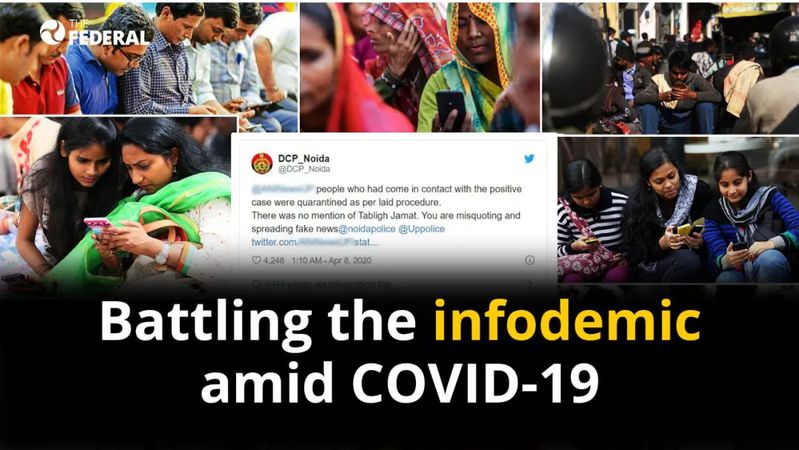
8
India is still under lockdown and the future seems uncertain. New cases are being reported on a daily basis. While some provinces could control the things better, the cases are growing exponentially in other parts. Experts are busy making decisions and administrative systems are working like a machine to contain the issue with less damage. Indians have always showed resilience at the time of emergency and the unity in all its diversity equips the people to face challenges with much vigour. The threat hangs over the whole humanity, it is our duty to rose to the occasion for the betterment of a shared future. It requires keeping away our prejudices and enmity to focus on cooperation and benevolence. Solution lies in harmony. In a world, where everything is interdependent, humanity should come forward to help and support each other to build a better tomorrow.
Writer:Vishnu Karuthodi
(Doctoral Student, Institute of Communication Studies, Communication University of China)
Editor and Translate:Yang Yixuan
Endnotes :
[1]Chaudhuri, D. R. (2020, February 27). Coronavirus: India brings back 36 foreigners and 76 nationals from Wuhan. The Economic Times. Retrieved from https://economictimes.indiatimes.com/news/politics-and-nation/coronavirus-india-brings-back-36-foreigners-and-76-nationals-from-wuhan/articleshow/74328899.cms
[2]India coronavirus: Modi announces 21-day nationwide lockdown, limiting movement of 1.4bn people. (2020, March 24). INDEPENDENT. Retrieved from
https://www.independent.co.uk/news/world/asia/india-coronavirus-lockdown-modi-speech-cases-update-news-a9421491.html
[3]India locks down over 100 million people amid coronavirus fears. (2020, March 23). ALJAZEERA. Retrieved from https://www.aljazeera.com/news/2020/03/scores-indian-districts-lockdown-coronavirus-200323041150247.html
[4]Gunjan, R. K. (2020, March 25). National Lockdown Starts To Contain Coronavirus. NEWS 18. Retrieved from https://www.news18.com/news/india/national-lockdown-starting-midnight-to-contain-coronavirus-here-is-the-list-of-dos-and-donts-2549717.html
[5]Gettleman, J., & Schultz, K. (2020, March 24). Modi Orders 3-Week Total Lockdown for All 1.3 Billion Indians. The New York Times. Retrieved from
https://www.nytimes.com/2020/03/24/world/asia/india-coronavirus-lockdown.html
[6]Coronavirus: United Nations praises India's 'comprehensive' lockdown. (2020, March 25). THE WEEK. Retrieved from https://www.theweek.in/news/india/2020/03/25/coronavirus-united-nations-praises-india-comprehensive-lockdown.html
[7]Kidangoor, A. (2020, March 31). Modi's Hasty Coronavirus Lockdown of India Leaves Many Fearful for What Comes Next. TIME. Retrieved from https://time.com/5812394/india-coronavirus-lockdown-modi/
[8]Gettleman, J., & Schultz, K. (2020, March 24). Modi Orders 3-Week Total Lockdown for All 1.3 Billion Indians. The New York Times. Retrieved from
https://www.nytimes.com/2020/03/24/world/asia/india-coronavirus-lockdown.html
[9] Economic Survey. (n.d.). Retrieved from https://www.indiabudget.gov.in/economicsurvey/
[10]Kidangoor, A. (2020, March 31). Modi's Hasty Coronavirus Lockdown of India Leaves Many Fearful for What Comes Next. TIME. Retrieved from https://time.com/5812394/india-coronavirus-lockdown-modi/
[11]Covid-19: Rs 1.7-trn relief package welcome, but more support needed. (2020, March 27). Business Standard. Retrieved from https://www.business-standard.com/article/economy-policy/covid-19-rs-1-7-trn-relief-package-welcome-but-more-support-needed-120032601284_1.html
[12]India coronavirus: $22bn bailout announced for the poor. (2020, March 27). BBC. Retrieved from https://www.bbc.com/news/world-asia-india-52047263
[13]FM Nirmala Sitharaman announces Rs 1.7 lakh crore relief package for poor. (2020, March 27). The Economic Times. Retrieved from https://economictimes.indiatimes.com/news/economy/policy/fm-nirmala-sitharaman-announces-rs-1-7-lakh-crore-relief-package-for-poor/articleshow/74825054.cms
[14]M.K., N. (2020, March 20). How to make sense of Kerala's mega COVID-19 financial package. Livemint. Retrieved from https://www.livemint.com/news/india/how-to-make-sense-of-kerala-s-mega-covid-19-financial-package-11584702247868.html
[15]Masih, N. (2020, April 10). How the Indian state of Kerala flattened its coronavirus curve. The Washington Post. Retrieved from https://www.washingtonpost.com/world/aggressive-testing-contact-tracing-cooked-meals-how-the-indian-state-of-kerala-flattened-its-coronavirus-curve/2020/04/10/3352e470-783e-11ea-a311-adb1344719a9_story.html
[16]Rawat, M. (2020, April 9). Coronavirus in India: In 13 states, NGOs fed more people than govt did during lockdown. INDIA TODAY. Retrieved from https://www.indiatoday.in/india/story/in-13-states-ngos-fed-more-people-than-govt-during-coronavirus-lockdown-1665111-2020-04-09
[17]Chaudhuri, D. (2020, March 24). China extends support to India to fight Covid-19 . THE ECONOMIC TIMES. Retrieved from https://economictimes.indiatimes.com/news/politics-and-nation/china-extends-support-to-india-to-fight-covid-19/articleshow/74799620.cms?utm_source=contentofinterest&utm_medium=text&utm_campaign=cppst
[18]Chaudhuri, D. (2020, March 24). China extends support to India to fight Covid-19 . THE ECONOMIC TIMES. Retrieved from https://economictimes.indiatimes.com/news/politics-and-nation/china-extends-support-to-india-to-fight-covid-19/articleshow/74799620.cms?utm_source=contentofinterest&utm_medium=text&utm_campaign=cppst
[19]Internet users in India to reach 627 million in 2019: Report. (2019, March 6). THE ECONOMIC TIMES. Retrieved from https://economictimes.indiatimes.com/tech/internet/internet-users-in-india-to-reach-627-million-in-2019-report/articleshow/68288868.cms?utm_source=contentofinterest&utm_medium=text&utm_campaign=cppst
[20]Mandavya, M. (2019, September 26). India has second highest number of Internet users after China: Report. THE ECONOMIC TIMES. Retrieved from https://economictimes.indiatimes.com/tech/internet/india-has-second-highest-number-of-internet-users-after-china-report/articleshow/71311705.cms?utm_source=contentofinterest&utm_medium=text&utm_campaign=cppst
[21]India has the cheapest mobile data in world: Study. (2019, March 6). THE ECONOMIC TIMES. Retrieved from https://economictimes.indiatimes.com/tech/internet/india-has-the-cheapest-mobile-data-in-world-study/articleshow/68285820.cms?utm_source=contentofinterest&utm_medium=text&utm_campaign=cppst
[22]Mankotia, A. S. (2020, April 1). Mobile internet usage increases just 10% since lockdown. THE ECONOMIC TIMES. Retrieved from https://economictimes.indiatimes.com/tech/internet/mobile-internet-usage-increases-just-10-since-lockdown/articleshow/74920799.cms?utm_source=contentofinterest&utm_medium=text&utm_campaign=cppst
[23]Data consumption in rural India jumped nearly 100% during lockdown: CSC CEO. (2020, April 5). Business Standard. Retrieved from https://www.business-standard.com/article/current-affairs/data-consumption-in-rural-india-jumped-nearly-100-during-lockdown-csc-ceo-120040500737_1.html
[24] Laghate, G. (2020, March 25). Video streaming services like Netflix, Hotstar suspend HD streaming on cellular networks. THE ECONOMIC TIMES. Retrieved from https://economictimes.indiatimes.com/industry/media/entertainment/video-streaming-services-like-netflix-hotstar-suspend-hd-service-on-cellular-networks/articleshow/74807392.cms?utm_source=contentofinterest&utm_medium=text&utm_campaign=cppst
[25]Singh, S. (2020, April 7). How TikTok is giving Facebook a run for its money during India’s Coronavirus lockdown. FINANCIAL EXPRESS. Retrieved from
https://www.financialexpress.com/industry/technology/how-tiktok-is-giving-facebook-a-run-for-its-money-during-indias-coronavirus-lockdown/1921096/
[26]India profile - Media. (2019, April 29). BBC. Retrieved from https://www.bbc.com/news/world-south-asia-12557390
[27] Mukunth, V. (2020, February 2). 'No Meat, No Coronavirus' Makes No Sense. THE WIRE. Retrieved from https://web.archive.org/web/20200303034133/http://thewire.in/health/meat-eating-2019-novel-coronavirus-wuhan-bats-proteins-cattle-climate-cow-vigilantism
[28]Coronavirus: Does drinking tea help? (2020, March 25). BBC. Retrieved from https://www.bbc.com/news/world-asia-india-51910099
[29]Prabhakar, S. (2020, March 20). Covid-19: Northeast India Welfare Association complains of racial discrimination in Chennai. Times of India. Retrieved from
https://timesofindia.indiatimes.com/city/chennai/covid-19-northeast-india-welfare-association-complains-of-racial-discrimination-in-chennai/articleshow/74733326.cms
[30]Bisht, A., & Naqvi, S. (2020, April 7). How Tablighi Jamaat event became India's worst coronavirus vector. ALJAZEERA. Retrieved from https://www.aljazeera.com/news/2020/04/tablighi-jamaat-event-india-worst-coronavirus-vector-200407052957511.html
[31]UP: Man in police net for spreading WhatsApp rumour on coronavirus. (2020, April 4). INDIA TODAY. Retrieved from https://www.indiatoday.in/coronavirus-outbreak/story/up-man-police-net-spreading-whatsapp-rumour-coronavirus-1663175-2020-04-04
[32]Indian government asks social media firms to control Coronavirus fake news. (2020, March 20). THE ECONOMIC TIMES. Retrieved from https://economictimes.indiatimes.com/tech/internet/indian-government-asks-social-media-firms-to-control-coronavirus-fake-news/articleshow/74734697.cms
